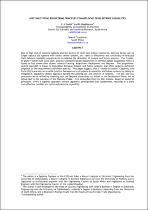JavaScript is disabled for your browser. Some features of this site may not work without it.
- ResearchSpace
- →
- Research Publications/Outputs
- →
- Conference Publications
- →
- View Item
| dc.contributor.author |
Smith, CJ

|
|
| dc.contributor.author |
Oosthuizen, Rudolph

|
|
| dc.date.accessioned | 2011-10-13T09:52:28Z | |
| dc.date.available | 2011-10-13T09:52:28Z | |
| dc.date.issued | 2011-09 | |
| dc.identifier.citation | Smith, CJ and Oosthuizen, R. 2011. Applying systems engineering principles towards developing defence capabilities. International Conference on Industrial Engineering, Systems Engineering and Engineering Management for Sustainable Global Development, Stellenbosch, South Africa, 21-23 September 2011 | en_US |
| dc.identifier.uri | http://hdl.handle.net/10204/5231 | |
| dc.description | International Conference on Industrial Engineering, Systems Engineering and Engineering Management for Sustainable Global Development, Stellenbosch, South Africa, 21-23 September 2011 | en_US |
| dc.description.abstract | Due to high cost of defence systems and the advent of multi-role military platforms, defence forces can no longer replace old systems with similar newer systems, but need to effectively and continually re-evaluate their defence capability requirements to optimise the utilisation of current and future systems. The “cradle-to-grave” System Life Cycle (SLC) process underpinning the Department of Defence (DOD) Acquisition Policy is based on four consecutive phases, namely Planning, Acquisition, Deployment and Disposal. This programme-centric approach is prone to disjunction between present and future systems, and often neglects sufficient emphasis on the requirements definition activity. This paper suggests that a “cradle-to-cradle” Capability Life Cycle (CLC) process can provide junction between current systems in operation and future systems by taking an integrative, capability-centric approach toward the phasing out and renewal of systems. The SLC and CLC processes can be unified by observing that the disposal phase does not follow on the deployment phase, but in actual fact is the outcome of the Planning Phase. It is contended that the CLC process, based on sound SE principles, offers a superior approach toward capability development and sustainment, resulting in a more cost-effective (smaller and optimised) defence capability. | en_US |
| dc.language.iso | en | en_US |
| dc.relation.ispartofseries | Workflow request;7052 | |
| dc.subject | Defence evaluation | en_US |
| dc.subject | Defence requirements | en_US |
| dc.subject | Capability life cycle | en_US |
| dc.subject | System life cycle | en_US |
| dc.subject | Defence systems engineering | en_US |
| dc.subject | Systems engineering | en_US |
| dc.subject | Engineering management | en_US |
| dc.subject | Sustainable global development | en_US |
| dc.title | Applying systems engineering principles towards developing defence capabilities | en_US |
| dc.type | Conference Presentation | en_US |
| dc.identifier.apacitation | Smith, C., & Oosthuizen, R. (2011). Applying systems engineering principles towards developing defence capabilities. http://hdl.handle.net/10204/5231 | en_ZA |
| dc.identifier.chicagocitation | Smith, CJ, and Rudolph Oosthuizen. "Applying systems engineering principles towards developing defence capabilities." (2011): http://hdl.handle.net/10204/5231 | en_ZA |
| dc.identifier.vancouvercitation | Smith C, Oosthuizen R, Applying systems engineering principles towards developing defence capabilities; 2011. http://hdl.handle.net/10204/5231 . | en_ZA |
| dc.identifier.ris | TY - Conference Presentation AU - Smith, CJ AU - Oosthuizen, Rudolph AB - Due to high cost of defence systems and the advent of multi-role military platforms, defence forces can no longer replace old systems with similar newer systems, but need to effectively and continually re-evaluate their defence capability requirements to optimise the utilisation of current and future systems. The “cradle-to-grave” System Life Cycle (SLC) process underpinning the Department of Defence (DOD) Acquisition Policy is based on four consecutive phases, namely Planning, Acquisition, Deployment and Disposal. This programme-centric approach is prone to disjunction between present and future systems, and often neglects sufficient emphasis on the requirements definition activity. This paper suggests that a “cradle-to-cradle” Capability Life Cycle (CLC) process can provide junction between current systems in operation and future systems by taking an integrative, capability-centric approach toward the phasing out and renewal of systems. The SLC and CLC processes can be unified by observing that the disposal phase does not follow on the deployment phase, but in actual fact is the outcome of the Planning Phase. It is contended that the CLC process, based on sound SE principles, offers a superior approach toward capability development and sustainment, resulting in a more cost-effective (smaller and optimised) defence capability. DA - 2011-09 DB - ResearchSpace DP - CSIR KW - Defence evaluation KW - Defence requirements KW - Capability life cycle KW - System life cycle KW - Defence systems engineering KW - Systems engineering KW - Engineering management KW - Sustainable global development LK - https://researchspace.csir.co.za PY - 2011 T1 - Applying systems engineering principles towards developing defence capabilities TI - Applying systems engineering principles towards developing defence capabilities UR - http://hdl.handle.net/10204/5231 ER - | en_ZA |






